
| WWT Shows | CLICK TO: Join and Support Internet Horology Club 185™ | IHC185™ Forums |

|
• Check Out Our... • • TWO Book Offer! • |
Welcome Aboard IHC185™  Internet Horology Club 185
Internet Horology Club 185  IHC185™ Discussion Site Main Page
IHC185™ Discussion Site Main Page  Open to the World RESEARCH FORUMS
Open to the World RESEARCH FORUMS  Ball Watch Company Research Forum
Ball Watch Company Research Forum  Ball-Hamilton or Ball-Waltham 16-size Movement???
Ball-Hamilton or Ball-Waltham 16-size Movement???
 Internet Horology Club 185
Internet Horology Club 185  IHC185™ Discussion Site Main Page
IHC185™ Discussion Site Main Page  Open to the World RESEARCH FORUMS
Open to the World RESEARCH FORUMS  Ball Watch Company Research Forum
Ball Watch Company Research Forum  Ball-Hamilton or Ball-Waltham 16-size Movement???
Ball-Hamilton or Ball-Waltham 16-size Movement???Go  | New Topic  | Find-Or-Search  | Notify  | Tools  | Reply to Post  |  |
Ball-Hamilton or Ball-Waltham Movement??? Hi, I just got a 16S described as Ball-Hamilton and I wonder whether this actually is a Ball-Waltham (which case no good for me). Only 16S 19J movements Hamilton made were 952 (bridge) and 996 which both have motor barrel according to my records: This is how it was described: - 16S 19J Ball-Hamilton, ca 1903 - ¾ plate movement - gold train - Ball Circular style damascening - Signed "Ball Watch Co., Cleveland, O., Trade Mark, Official RR (within a gold shield) Standard, Adjusted, Pat. Nov. 17.96 - Serial #B200461 On Fine Times there is one Hamilton and one Waltham, look pretty much the same to me. Anyone out there who can give some expert advice please? Pictures following. Thanks!/Chris Schirren | |||
|
Picture 2  | ||||
|
Picture 3 (last) | ||||
|
| IHC President Life Member |
Chris, You are entirely correct, there were no 16-size, 19-jewel Ball Hamilton movements. In fact the first Ball-Hamilton 16-size movements were from a run beginning with B600001 in 1910 production. The other information you were provided is correct but the watch is in fact a Ball-Waltham from about 1903 production. I would also expect that movement to be lever-set. It does have a fairly uncommon and correct dial and all three hands look right. Now, how to determine whether an open-face Ball 16-size is a Ball-Hamilton or Ball-Waltham movement. Examine the comparison image you will find below this message. On the left is a Ball-Hamilton and on the right a Ball-Waltham is shown. Although there are differences in hair-spring studs and regulators, to me the fast and easy way to tell which is which would be the winding wheel design and most importantly case-screw locations. Positioning the movement in question with the pendant at top and calling that the 12:00 position, carefully check the case-screw locations. On a Ball-Hamilton movement you will find the case-screws are at approximately the 11 and 5 positions indicated by yellow arrows below whereas the Ball-Waltham has them at about the 1 and 7 positions. Ball-Waltham Open-Face movements will always look like the example with the red arrows shown below on the right in the image below this posting. Now, this is where it may become a little confusing, the later Ball-Hamilton 999B will be different, as will a Ball-Illinois. But the Ball-Hamilton 999B will have clear 999B markings and the Ball-Illinois is very a very distinctive 23-Jewel movement. Remember this, simply stated, on Open-Faced movements, if you find these three features (A) the case-screws positions at 1 and 7 as you see them on the right (B) along with dished winding wheels and (C) a gold seal then it will always be a Ball-Waltham movement. Ball-Hamilton on the left, Ball-Waltham on the right... 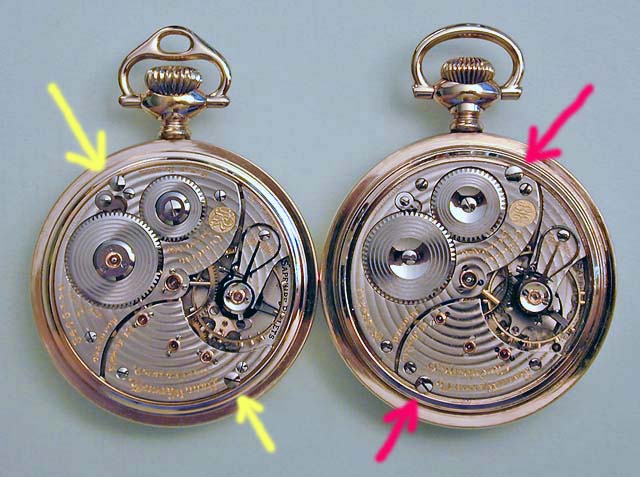 | |||
|
Thanks a lot Lindell. It's a shame, was really looking forward to this watch but want to limit my collection activitites to Hamilton. If anyone wants this watch I gladly pass on the info where to get it (UK), my auction price was $ 270 plus shipping. Chris. | ||||
|
Chris, I am partial to Waltham's and would be interested in this watch. Ed | ||||
|
Hello Lindell: Re. your post above: Ball-Hamilton or Ball-Waltham 16 size movement. This post has convinced me that my 16S-19 Jewel Ball #B640319 is a Ball-Waltham after comparing your red/yellow domonstration of the differences. With this said I am still confused about the production date since the Engle/Shugart Guide Book shows the Waltham Serial #' stopping at 270,000 in 1925. Please help!!! Thanks, Sam | ||||
|
| IHC President Life Member |
Hi Sam, You bring up some interesting points. First, yours is a Ball-Waltham, not only from the movement number and case-screw layout but the fact Hamilton did not make any 19-Jewel Ball watches, secondly, there were about 64,000 of the Ball-Walthams produced. To make sense of the numbers we must begin with the first run consisting of B060701-B061100 during 1899 production, those numbers were blocked using the last six digits of Waltham production which at the time was in the nine millions. So we can extrapolate Waltham numbers 9060701-9061100 as being the same as Ball numbers that began with "B060701" and comparing Waltham numbers "9060701" which were arrived at by substituting the "B" for the "9" at the beginning of the movement number. That means the lowest numbered Ball-Waltham, number B060701 would be the same as Watham 9060701 or 9,060,701 meaning nine million, sixty thousand, seven-hundred first Waltham movement. For reference, here is an image of B060713 from the first run. This odd numbering system went on through the last run of Ball-Waltham 16-size movements which was a run blocked as B270001-B271000 that began in 1922 production. At that point, Waltham was in the 24 millions, so in that instance, replace the "B" with "24" to correlate with the Waltham production numbers. As you now see the Ball-Waltham numbers are not a continuous, consecutive numbering system but rather a "code" as it were, although they were indirectly related to Waltham numbers, this is really like something out of a spy novel. All of the Ball-Waltham movement numbers were achieved using the code we speak of, for example your B640319 converts to 12640319 in Waltham numbers. Your run consisted of B640001-B640800 during 1903 production at which point Waltham was numbering in the twelve millions, so substitute "12" for the "B" and you are into Waltham numbering. By the way, that particular run consisted of both 17 and 19-Jewel movements, most Ball watches were from blocked, reserved groups of numbers or "mixed runs" such as that one. All of this foolishness with the numbers was part and parcel to the widely accepted myth that Webb C. Ball was a "watch manufacturer" which he was not in the way most of us define the term. However, it is important to understand the final adjusting, installation of dial and hands then casing and timing was done at the Ball facility in Cleveland which gave credence to his "manufacturer" status. Your watch went through that process at "The Ball Building" at the corner of Superior Road and Seneca at some point in the third year of the 20th Century. Hope this helps you and others to "crack the code" on Ball-Waltham numbers. Lindell | |||
|
Thanks Lindell this great information. As I read this my mind wondered who cracked "the code." Unless you have gone through this process for many years it would be almost impossible to have the exact dates of watch production. Look at it this way, my watch went from Hamilton-Ball overnight and got much older. Thanks again for your wonderful knowledge that you are able to pass on. Sam | ||||
|
I know this is an old posting but hopefully someone can respond. I recently acquired a Ball-Waltham pocket watch, 16 jewel, with a serial number B641868. I was getting confusing information on its age from a number of sources. On the website, pocketwatchdatabase.com, it reported a production year of 1903. That seems to fit with information shared by Mr. Riddle's comments, although just outside of the range he listed in his posting. Is it safe to assume year 1903 is a reasonable number? | ||||
|
| IHC Member 1291 |
My "kept" records deal with "RR" grade watches. I show, as does Lindell a 800 piece run from B640,001-B640,800 and they show to be a mixed run of 17-19 jewel watches from 1903. At that point onward in time, the numbers went back to B202,001 through B271,000 made/blocked after B640,800. [ These numbers were "blocked" and dates produced may or may not be exact.] B202,001 was the 12,202,001 watch made by Waltham in 1903 and B271,000 was the 24,271,000 watch made in 1922 that Waltham made [or "blocked"]. Is your watch by chance a "commercial standard" ?? Most of the 16 jewel Ball Walthams were commercial standard and not RR watches. Post a picture of the watch front and back [dial & movement], and we will know more..... We have a member out of the "States" that knows quite a bit about the Ball watches, after you post a picture perhaps he will share his expertise. Here's a pair of pictures of my last 16 J Ball Commercial Standard that I have since sold. regards, bb 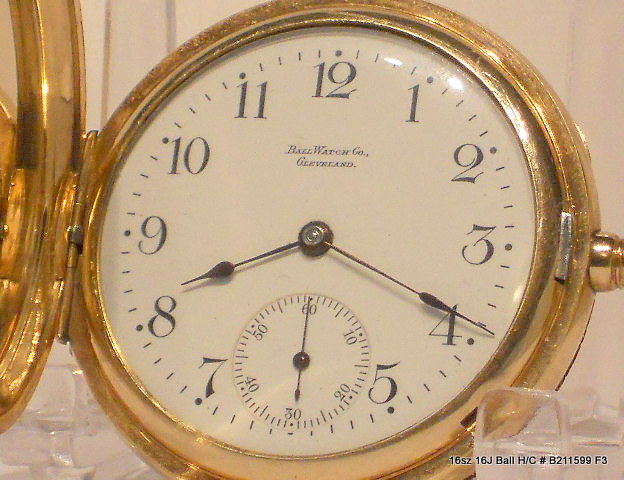 | |||
|
| IHC Member 1291 |
Movement;  | |||
|
It is a commercial standard, not RR certified. I have some photos on my iPad but they are apparently too big to upload. Let me see if I can shrink them. | ||||
|
The movement. 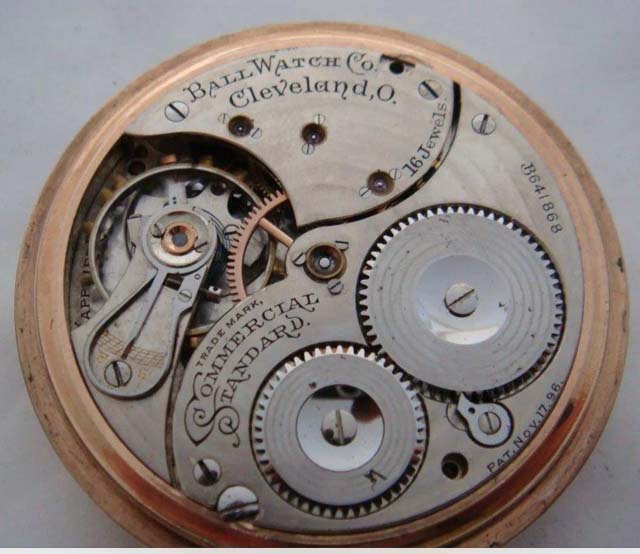 | ||||
|
The face. 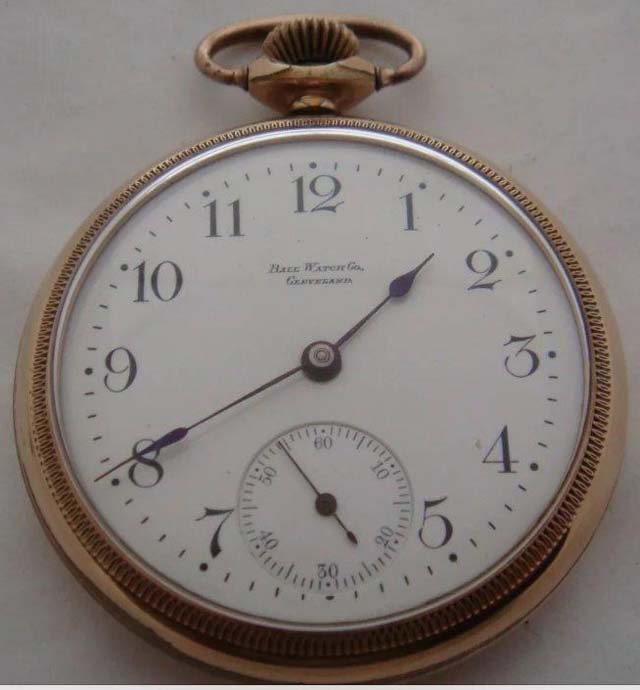 | ||||
|
Not sure if of any benefit, but this is a screenshot of what the pocketwatchdatabase.com reported 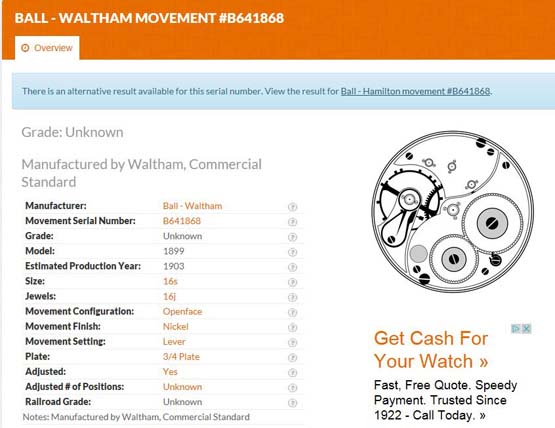 | ||||
|
Hi Roger, Looks like you are missing a couple of screws on your movement. The top one is the case screw. And the bottom one is for the bridge cover (plate) for the mainspring (barrel) of the watch. Would want to get the proper screws into both of those slots before winding up the movement. All the best j  | ||||
|
Thanks for pointing that out. I had dropped it off early this week to be cleaned and serviced so will see if they catch that. It ran but gained 15-20 minutes daily. I'm a "novice" with watches. | ||||
|
| Powered by Social Strata |
| Your request is being processed... |
|
Welcome Aboard IHC185™  Internet Horology Club 185
Internet Horology Club 185  IHC185™ Discussion Site Main Page
IHC185™ Discussion Site Main Page  Open to the World RESEARCH FORUMS
Open to the World RESEARCH FORUMS  Ball Watch Company Research Forum
Ball Watch Company Research Forum  Ball-Hamilton or Ball-Waltham 16-size Movement???
Ball-Hamilton or Ball-Waltham 16-size Movement???
 Internet Horology Club 185
Internet Horology Club 185  IHC185™ Discussion Site Main Page
IHC185™ Discussion Site Main Page  Open to the World RESEARCH FORUMS
Open to the World RESEARCH FORUMS  Ball Watch Company Research Forum
Ball Watch Company Research Forum  Ball-Hamilton or Ball-Waltham 16-size Movement???
Ball-Hamilton or Ball-Waltham 16-size Movement???©2002-2025 Internet Horology Club 185™ - Lindell V. Riddle President - All Rights Reserved Worldwide

